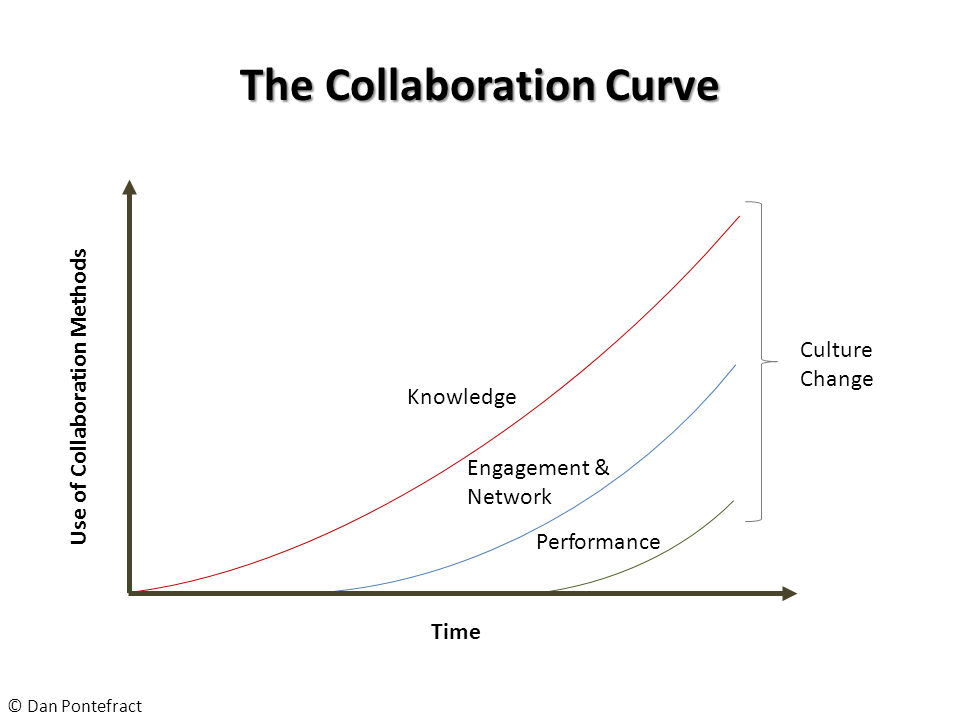Now that I’m on a mission to merge the terms Social Business and Enterprise 2.0 and rephrase as
Collaboration, I thought it would be a good time to introduce “
The Collaboration Curve”.

Over a period of time, and as collaboration methods between citizens increase (employee to employee, employee to customer, student to faculty, etc.), so too will an increase be found in knowledge, engagement, networks and performance of said individual participating in the collaboration experience. Each increase will occur, however, with stunted delay until such time in which they collide, thus ideally resulting in positive culture change for the organization.
In simpler terms, to really address positive culture change, we should think through how we might use collaboration methods to bridge the gap between any real or perceived gain in knowledge, engagement, networks and performance.
Collaboration methods, for example, are the use of formal and non-formal sharing tools whether online or in-person but predominantly online. We can include such opportunities as wikis, blogs, micro-blogging, user-generated videos and webinars, discussion forums, virtual worlds, mentoring, coaching, chalk talks, etc.
Stage One - Knowledge
- Maybe through lurking, maybe through ease of access, maybe through the pure magnitude of collaborative opportunities, knowledge is the first domain to increase when collaboration methods are understood, learned properly, and obviously being utilized in effective ways. It increases first because, typically, we are not obligated to give back – we can take all we want, and this is through the process of adopting (and adapting) to collaboration technologies and methods.
Stage Two – Engagement and Network
- As knowledge continues to increase and there is a level of comfortableness using various collaboration methods, there should be a correlated increase in user engagement due to the fact their network is also increasing through their participation in collaboration methods. Knowledge has increased through the use of the collaboration methods, a level of equanimity ensues and the number of strong and weak ties should increase, thus furthering overall engagement of the user. (see The Strength of Weak Ties, Mark S. Granovetter, The American Journal of Sociology Vol. 78, No. 6 (May, 1973), pp. 1360-1380)
Stage Three – Performance
- Knowledge continues to surge, level of user engagement and their corresponding network is on the rise, collaboration methods now become the norm and so, arguably, performance of the individual will increase. Performance is the ability to raise the output without detrimentally affecting the level of quality in the work or the engagement of the user. If all goes well within the curve, this is the ‘sweet spot’. I liken the thoughts of John Hagel III, John Seely Brown and Lang Davison to this stage of the “Collaboration Curve” … although they actually have previously referred to it as the ‘collaborative curve’ uniquely.
Final Stage – Culture Change
- I’m not suggesting the culture of your organization needs to change; rather, it will change organically over time. The question is not when, but how will you help address and facilitate the culture change (over time) through the use of collaboration methods? If you can close the gap between the three stages, your organization may be in a position to increase performance faster. If you are reckless or asleep at the wheel, other organizations that actually are in fact utilizing a model like “The Collaboration Curve” just may have your lunch in a few quarters or years without you knowing it. (see ERP Graveyard examples for starters)
In conclusion, the three stages (knowledge, engagement / network, and performance) actually help provide a framework for what JP Rangaswami refers to as “
The Maker Generation” eventually leading to organizational culture change. I like to think I’m one of those ‘makers’ but this framework helps me put things into perspective for all levels of an organization. Hopefully it helps you too.
Next up will be “The Collaboration Cycle”. Stay tuned.
 Over a period of time, and as collaboration methods between citizens increase (employee to employee, employee to customer, student to faculty, etc.), so too will an increase be found in knowledge, engagement, networks and performance of said individual participating in the collaboration experience. Each increase will occur, however, with stunted delay until such time in which they collide, thus ideally resulting in positive culture change for the organization.
In simpler terms, to really address positive culture change, we should think through how we might use collaboration methods to bridge the gap between any real or perceived gain in knowledge, engagement, networks and performance.
Collaboration methods, for example, are the use of formal and non-formal sharing tools whether online or in-person but predominantly online. We can include such opportunities as wikis, blogs, micro-blogging, user-generated videos and webinars, discussion forums, virtual worlds, mentoring, coaching, chalk talks, etc.
Stage One - Knowledge
Over a period of time, and as collaboration methods between citizens increase (employee to employee, employee to customer, student to faculty, etc.), so too will an increase be found in knowledge, engagement, networks and performance of said individual participating in the collaboration experience. Each increase will occur, however, with stunted delay until such time in which they collide, thus ideally resulting in positive culture change for the organization.
In simpler terms, to really address positive culture change, we should think through how we might use collaboration methods to bridge the gap between any real or perceived gain in knowledge, engagement, networks and performance.
Collaboration methods, for example, are the use of formal and non-formal sharing tools whether online or in-person but predominantly online. We can include such opportunities as wikis, blogs, micro-blogging, user-generated videos and webinars, discussion forums, virtual worlds, mentoring, coaching, chalk talks, etc.
Stage One - Knowledge






